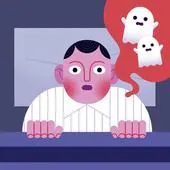Spring asthenia: how to differentiate its symptoms and how to combat it
[ad_1]
Get up tired. Drowsiness during the day, bad sleep at night. Apathy. Lack of energy. “I’m feeling low”. “I can’t handle life.” “The time change kills me”… Popular diagnosis: spring. More specifically, spring asthenia, which during the first weeks of March, with the change of seasons, usually fills medical consultations even though it is not an illness.
According to the Spanish Society of General and Family Physicians (SEMG) “approximately 40% of Spaniards are susceptible to suffering from spring asthenia annually.” It mainly affects children and the elderly, “more vulnerable to the physical effects produced by the environmental changes of this season.” Other studies indicate, however, that it mainly affects people between 20 and 50 years old, mostly women. Although there is another pile of research that ensures that it is men who suffer from it the most. Wow, everyone is predisposed to suffer from it.
But to suffer what? Because does spring asthenia exist? Yes, but it is not considered a pathology nor does it appear as such in the Catalog of International Classification of Diseases of the World Health Organization (WHO). Spring asthenia is an adjustment disorder. “It can be understood as a process of adaptation to the change in environmental factors” typical of the onset of spring, such as the increase in temperature, changes in atmospheric pressure and humidity, more hours of daylight and time change, “which cause symptoms of fatigue, daytime sleepiness, difficulty concentrating, lightheadedness, irritability that do not last longer than two weeks,” according to doctor Santiago Taboada, from the aforementioned SEMG.
So, whether due to one factor or another, it is likely that with the arrival of spring we may feel more fatigued than normal and suffer a mild clinical condition that will subside in a few days without major complications. And that can be prevented.
These are some of the guidelines that specialists suggest to prevent spring slump. The first may be shocking because it involves exercising, something that at first does not seem like a good idea if what you want is not to get tired. But no, exercising regularly helps keep our body in good condition, which prevents muscle pain and fatigue. Of course, it has to be an activity appropriate to our physical condition, progressive and aerobic. The stationary or strolling bicycle may be sufficient, as well as walking or strolling on flat ground.
Some guidelines
The second is to eat a healthy diet and reduce the consumption of fats and refined carbohydrates. The vitamins in fruits and vegetables help strengthen the immune system and prevent lack of energy. Meals must be ordered, with regular times. You have to avoid heavy dinners.
Good hydration is crucial for our body to function properly. It is advisable to drink water, natural juices and infusions and not abuse coffee and much less alcohol, which is the healthiest thing to do without. The sleep schedule has to be regular. You should try to go to bed and get up at the same time each day.
The psychologist María Padilla also adds two other recommendations to face spring asthenia and the feeling of sadness that it entails: «Patience, it is a matter of time before it passes. If you don’t pay as much attention to it it’s easier to hold it. It is there, there is no more. Finally, “enjoy the sun, the flowers, the spring weather.”
[ad_2]
Source link





